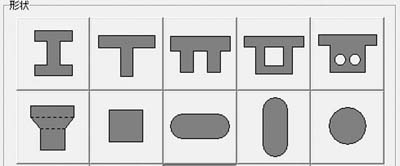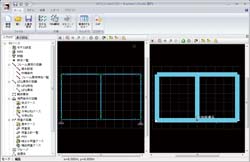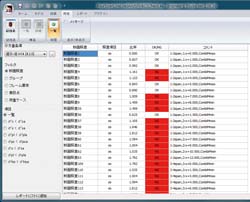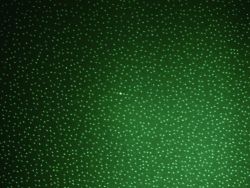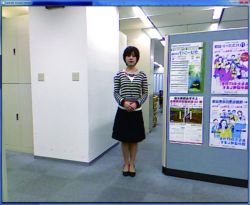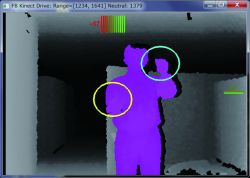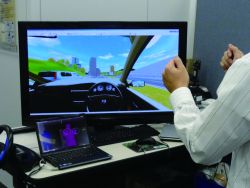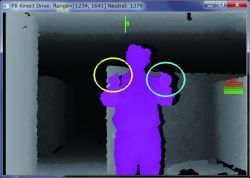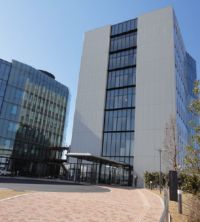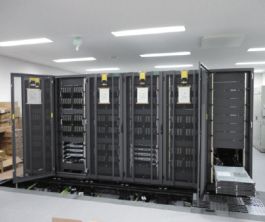International Newsletter vol.45 2011/4
4.28.2011 FORUM8 Co., Ltd. http://www.forum8.com/
|
| Engineer's Studio(R) 2D supports 2D in plane structural analysis. It is a reduced version of the Engineer's StudioR 3D product. This revised version includes three new features : 1. Input of cross-section shapes. 2. Section design checks. 3. Moving load influence line analysis for the railway design codes of Japan, in particular the train load "E load" type. Items 1 and 2 are chargeable upgrades and item 3 is covered by maintenance contracts. |
| Input of section form |
| Section design checks. |
| A section design check feature is available for reinforced concrete sections
as an option in this version. The checks include shear capacity, minimum
reinforcing, allowable bending stresses, ultimate moment capacity and average
shear stress in accordance with the Japan specification for highway bridges. 2D
in plane analysis is used and as such all design checks are uniaxial in their
nature. The uniaxial nature simplifies the user input and printed reports
compared to the biaxial checks done in the full 3D analysis program. (Figure
4). The calculated stress values etc are normalized by permitted values as per the code and a quick overview for all checks is available on the result form. If the normalized ratio exceeds 1.0, it is shown in red as NG. Sorting by the normalized ratio is supported to quickly identify critical areas of your structure. (Figure5).
|
| Moving load influence line analysis for railways. |
Engineer's Studio 2D supports a live load influence line analysis feature as
an option. This calculation supports moving groups of point loads (axles) in
conjunction with a trailing uniformly distributed load. This permits modeling of
the train live load "E load" type in Japan codes. (Figure 6).
|
| (Up&Coming 2011 Early Spring Issue) |
|
| Engineer's Studio(R) for Students is the students' version of Engineer's
Studio(R). It is provided for students' personal study only. The difference from
Engineer's Studio(R) is described below. License The license is provided only for an individual student. The student must prove that they belong to an academic institution including a university or professional school. The license is managed by a network authentication method via the internet. The user needs to have constant access to the Internet. Use for non-commercial purpose only It is prohibited to use this product for commercial purposes including but not limited to design and analysis. License effective period The license is valid for one year. It includes all product revisions during that time. The license will automatically cease to function after this period. To continue usage after this the license must be updated. User support The license does not include user support via telephone or e-mail. An online users' forum is provided as a means of obtaining assistance. See the "Engineer's Studio(R) Users Forum" below. |
| Overview of feature |
Engineer's Studio(R) for Students is a 3D FEM analysis program that has been
developed completely in-house. It includes preprocessing, calculation engine and
post processing (Figure1/2). Civil and Architectural structures can be modeled
with a variety of element types. Static and dynamic analysis can be undertaken.
In addition, there is a wide range of material nonlinear element types and
specific models within each element type.
Both material nonlinear and geometrical nonlinear (large displacement analysis) analyses are possible and these two effects can be modeled simultaneously. Fiber elements are supported. This is the element type that was used in the blind analysis contest (Note1). Mindlin plate elements are supported and in addition to material linear analysis the Maekawa nonlinear constitutive law of reinforced concrete (distributed crack model) developed in the concrete laboratory of Tokyo University is supported. Design features are also included and the student can gain experience in design including influence line analysis (for live load), reinforcing level checks, allowable stress calculations and ultimate strength checks for both shear and flexural actions. Note1) The analysis result of "Engineer's Studio(R)" won the E-Defense Pre-analysis Contest of Full scale RC Pier Earthquake Resistance Experiment! |
| Sharing information via the User Forum |
Users can freely share information with each other via the User Forum (http://es101bbs.forum8.co.jp/). This is an unofficial site and
our Engineer's Studio(R) Development Team will occasionally post on it. The
users can post on the site after login while their license is valid. The site is
available for viewing only in the absence of a license. If you wish to login to
the User Forum please contact our sales staff.
|
| (Up&Coming 2011 Early Spring Issue) |
|
|||||||||||||||||||||||||||||||||||||||||||
| ※Company name, products name are registered trademarks or trademark of their respective companies. | |||||||||||||||||||||||||||||||||||||||||||
 |
スーパーコンピュータ/HPC
|
| HPC
とスーパーコンピュータ HPC(high-performance computing)は、単位時間内の非常に計算量の多い処理を指して用いられる用語です。このような計算処理は、大規模な気象・災害の予測、分子・材料の研究、ゲノム情報解析などの医療・生命科学、騒音・音響・流体(水・風・熱など)などの解析、各種大規模実験の事前実験化(衝突実験・物理実験など)や宇宙科学の分野などでシミュレーション・可視化の際に用られます。 HPCを行う手段としては、超高速処理が可能なコンピュータであるスーパーコンピュータ(以下、スパコン)を使う方法が一般的です。スパコンに明確な基準はありませんが、概ねその時代の一般的なPCやサーバと比較して、はるかに高い演算性能(1,000倍以上)を持ちます。現在、文部科学省では1.5テラFLOPS(=1秒間に1.5兆回の計算性能)以上の性能を持つコンピュータをスパコンとして位置づけています。 一般的なPCとスパコンの大きな違いは、処理を並列で実行できる点にあります。前者は、1つの命令に対して1つの処理を実行しますが、システム中に数十から数十万個のプロセッサが搭載されているスパコンは、多数の計算を並行して実行することで超高速化が実現できる構造となっています。 このように、スパコンでは、一般のPCで処理できないような大規模な気象・災害予測、計算科学、物理シミュレーションなど、幅広い分野における計算を行うことができます。コンピュータ上の計算でさまざまな現象を再現するシミュレーションは、理論、実験に次ぐ第3の手法として、あらゆる研究開発において欠かせないツールとなっています。 2010年11月現在、スパコン世界上位500位までのランキング状況(TOP500)では、中国の天津国立スパコンセンターの「天河1号A」が世界最速となっており、約2.6ペタFLOPS(1ペタ=1秒間に1京回の計算性能)を達成しています。TOP10には中国の国産スパコンが3位にもランクインしているほか、米国製(6台)、フランス製のものもランクインしています。 日本では、東京工業大学のスパコン「TSUBAME2.0」(NEC/HP製)が4位を獲得し、第33位に日本原子力研究開発機構、第42位に東京大学物性研究所、第54位には2002~2004年の間、世界最速であった(独)海洋研究開発機構の「地球シュミレータ」が続いています。
次世代スパコン 京速コンピュータ「京」 現在、独立法人理化学研究所によって、次世代スパコン(京速コンピュータ「京」)の整備が兵庫県神戸市のポートアイランドにて進められています。「京」は、現在世界最速の約4倍となる10ペタFLOPS級の性能を実装し、完成予定の2012年に世界第1位になることを目標としています。 この次世代スパコン「京」が建設される神戸市のポートアイランド第2期エリアは、医療・バイオ系の企業や研究所および市民病院(移転)、最先端医療センターを集約することによって医療産業都市を目指しています。また神戸大学、兵庫医療大学、神戸夙川学院大学、神戸女子大学の4つの大学も建設中で、学術研究拠点として発展することも期待されています。 フォーラムエイトでは、2012年4月に次世代スパコン「京」に隣接して建設される「高度計算科学支援研究室 (財)計算科学振興財団(FOCUS)」内に“スパコンクラウドサービス研究室”を開設し、15テラFLOPS(=1秒間に15兆回の計算性能)以上のスパコンを利用したサービスの提供を開始する予定です。将来的には、2012年スタートの次世代スパコン「京」の活用ができるようサービスの高度化を目標としています。
|
| Overseas Training and Seminars |
Seminars in Shanghai,
Beijing and Seoul will be held on the following
schedule.
Venue:
Shanghai - Shanghai
Seminar room (FORUM8 Technology Development(Shanghai) Co.,
Ltd)
Seoul-FORUM 8 Korean
Office
| Seminar | Date | City |
| UC-win/Road VR | May 6th, 2011 | Shanghai |
| July 5th, 2011 | Shanghai | |
| July 6th, 2011 | Seoul | |
| UC-win/Road Advanced | June 2nd, 2011 | Shanghai |
| June 3rd, 2011 | Seoul | |
| UC-win/Road SDK | May 17th, 2011 | Shanghai |
| June 16th, 2011 | Seoul | |
| Engineer's
Studio(TM), Engineer's Studio(TM)(2D)) |
July 21st, 2011 | Shanghai |
| July 22nd, 2011 | Seoul | |
| VR-Studio(TM) | June 22nd, 2011 | Seoul |
| September 2nd, 2011 | Shanghai | |
| September 9th, 2011 | Seoul | |
| VR-Cloud(TM) |
July 27th, 2011 | Shanghai |
| July 28th, 2011 | Seoul | |
| Dynamic analysis | July 14th, 2011 | Shanghai |
| July 15th, 2011 | Seoul | |
| Allplan | May 18th, 2011 | Shanghai |
| May 19th, 2011 | Seoul | |
| UC-1 Introduction | June 9th, 2011 | Shanghai |
| June 10th, 2011 | Seoul | |
| xpswmm | June 24th, 2011 | Shanghai |
| Design Builder | July 1st, 2011 | Shanghai |
| July 2nd, 2011 | Seoul | |
| EXODUS / SMARTFIRE | May 10th, 2011 | Seoul |
| June 17th, 2011 | Shanghai | |
| September 21st, 2011 | Shanghai | |
| September 22nd, 2011 | Seoul | |
| Participation Fee | ||
| Participation Fee | Free | |
For more information and applications, please email us at
mailto:forum8@forum8.co.jpGross circulation:
To subscribe this page, go to http://www.forum8.co.jp/english/p-mail-e.htm
If you would like to unsubscribe from our newsletters, please include "Unsubscribe"
in the subject title of your email and send it back to us.
Thank you for your continued support.
FORUM8 Co., Ltd. mailto:forum8@forum8.co.jp
Nakameguro GT Tower 15F
2-1-1 Kamimeguro Meguro-ku Tokyo 153-0051 JAPAN
TEL +81-3-5773-1888
FAX +81-3-5720-5688
http://www.forum8.com/
